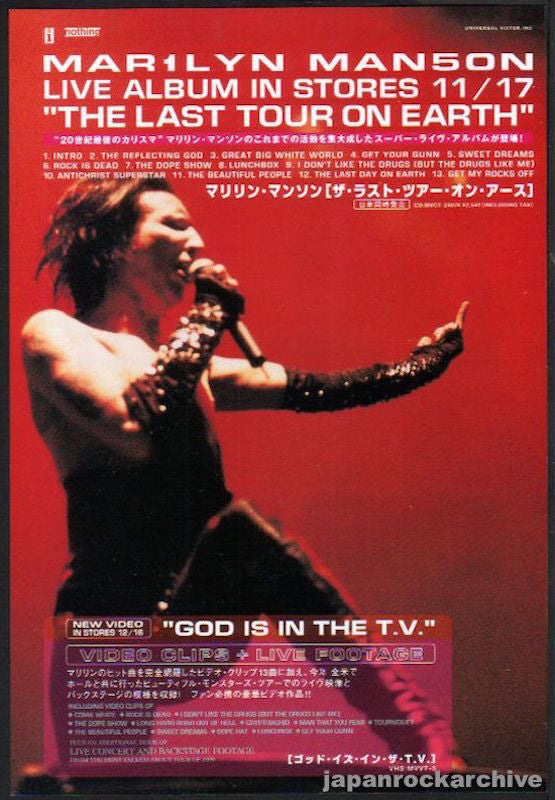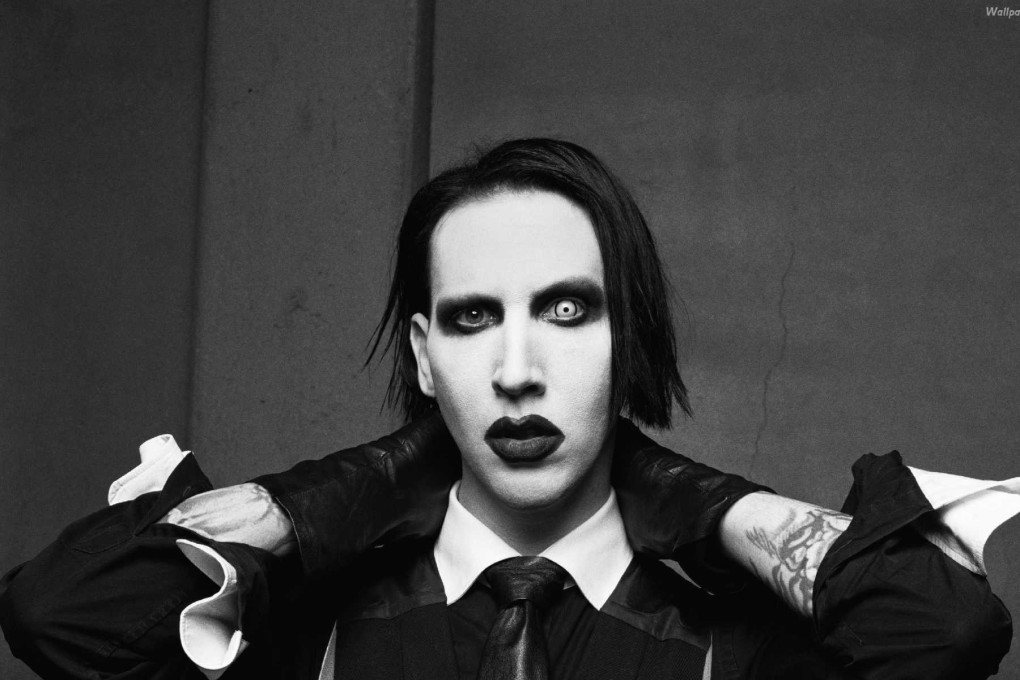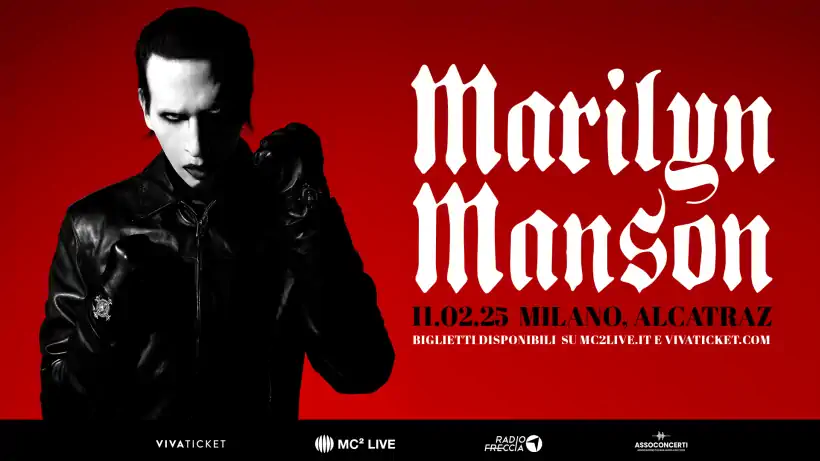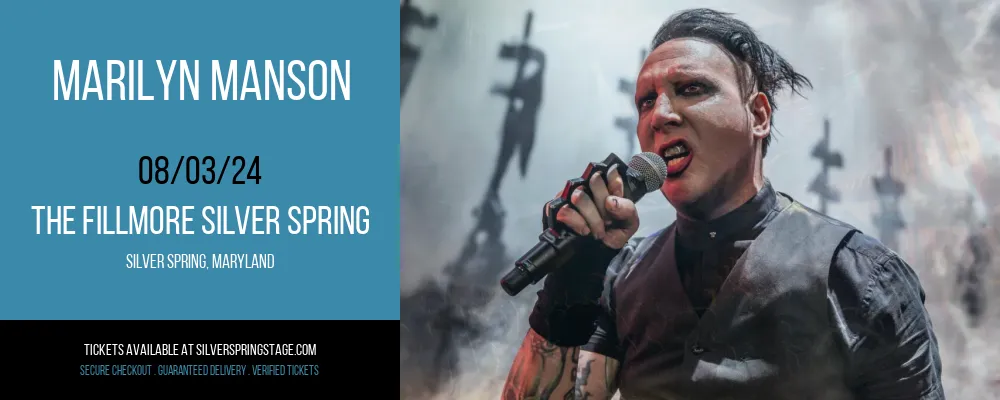New
Marilyn Manson’s Antichrist Superstar Returns A Look at the Tour’s Revival
Topic: Marilyn Manson Tour
Marilyn Manson’s tours have long been a central part of his career, serving as the stage for his unique blend of shock, spectacle, and sonic intensity. From the early days of the Spooky Kids to his current status as an enduring icon of industrial metal, Manson’s live performances have consistently pushed the boundaries of what a rock show can be. As he continues to evolve and reinvent himself, his latest tour, inspired by the 2020 album “We Are Chaos,” promises to be a captivating exploration of his artistic vision and the enduring legacy of his most iconic album, “Antichrist Superstar.”
The Revival of the Antichrist Superstar Era

- Revisiting a Seminal Album: “Antichrist Superstar” is widely regarded as one of Marilyn Manson’s most influential and groundbreaking albums. Released in 1996, it catapulted him into the mainstream and cemented his status as a provocative and uncompromising artist. The album’s dark themes, aggressive sound, and theatrical presentation have left an indelible mark on the music industry.
- Reconnecting with Longtime Fans: For many devoted Manson fans, the Antichrist Superstar era represents the pinnacle of his creative output and the height of his cultural impact. By revisiting this seminal album on tour, Manson is tapping into the nostalgia and passion of his long-standing fanbase, offering them a chance to relive the intensity and excitement of that formative period in his career.
- Introducing the Antichrist Superstar to a New Generation: While the Antichrist Superstar album has become a classic in its own right, a new generation of music fans may be discovering Manson’s work for the first time. By incorporating elements of this iconic album into his current tour, Manson has the opportunity to introduce the Antichrist Superstar to a younger audience, expanding his reach and ensuring the enduring legacy of this pivotal moment in his career.
The Evolution of Manson’s Stage Presence
- Blending Old and New: As Manson incorporates elements of Antichrist Superstar into his current live show, he will need to strike a delicate balance between honoring the past and showcasing his more recent artistic developments. This will require a careful curation of the setlist, costume design, and overall stage presentation, seamlessly blending the familiarity of the Antichrist Superstar era with the fresh creative energy of his latest musical endeavors.
- Adapting to Changing Times: The social and cultural landscape has evolved significantly since the release of Antichrist Superstar, and Manson will need to navigate this shift with sensitivity and nuance. His ability to recontextualize the album’s themes and imagery to reflect the current zeitgeist will be crucial in keeping his message relevant and resonant with modern audiences.
- Maintaining Theatrical Integrity: Manson’s live performances have long been celebrated for their cinematic quality, immersive visuals, and theatrical flair. As he revisits the Antichrist Superstar era, he will need to ensure that the production values and creative direction remain true to his artistic vision, captivating audiences with a spectacle that is both familiar and refreshingly innovative.
The Lasting Impact of Antichrist Superstar
- Solidifying Manson’s Legacy: The Antichrist Superstar album and tour marked a pivotal moment in Marilyn Manson’s career, propelling him into the mainstream and solidifying his status as a cultural icon. By revisiting this seminal work on his current tour, Manson has the opportunity to cement his legacy as one of the most influential and boundary-pushing artists of his generation.
- Inspiring a New Generation of Musicians: Antichrist Superstar has long been revered as a touchstone for industrial metal and alternative rock, inspiring countless musicians to push the boundaries of their own creative expression. By showcasing this album live, Manson can continue to inspire and influence the next generation of artists, solidifying his enduring impact on the music industry.
- Exploring the Enduring Themes of Antichrist Superstar: The themes explored on Antichrist Superstar, such as societal criticism, religious rebellion, and the nature of the self, continue to resonate with audiences today. Manson’s ability to revisit and recontextualize these themes within the framework of his current tour will demonstrate the timeless relevance of his artistic vision and the lasting impact of this landmark album.
The ‘We Are Chaos’ Era: Exploring Manson’s Latest Musical Influences on Tour

While Marilyn Manson’s career has been defined by his exploration of darker, more provocative themes, his latest album, “We Are Chaos,” has showcased a more introspective and nuanced side to his creative expression. As he prepares to take this new material on tour, Manson’s fans can expect a captivating blend of the familiar and the unexpected, as he weaves the sonic and thematic elements of “We Are Chaos” into his live performances.
The Sonic Evolution of “We Are Chaos”
- Expanding Manson’s Musical Palette: “We Are Chaos” represents a significant departure from the industrial metal sound that has long been associated with Manson’s music. The album features a more eclectic and experimental approach, incorporating elements of glam rock, alt-rock, and even hints of country music, showcasing Manson’s continued artistic growth and his willingness to push the boundaries of his own creative expression.
- Exploring Emotional Depth: Lyrically, “We Are Chaos” delves deeper into themes of introspection, vulnerability, and the complexities of the human experience. This shift in thematic focus is reflected in the album’s more emotive and nuanced sonic qualities, creating a listening experience that is both unsettling and deeply resonant.
- Collaborating with New Influences: The creative process behind “We Are Chaos” saw Manson collaborating with a diverse array of musical talents, including producer Shooter Jennings, known for his work in the country and Americana genres. This cross-pollination of influences has the potential to manifest in Manson’s live performances, offering audiences a fresh and unexpected take on his signature sound.
Blending Old and New on the Tour
- Incorporating “We Are Chaos” into the Setlist: As Manson prepares to take the “We Are Chaos” material on tour, he will need to carefully curate a setlist that seamlessly integrates the new songs with his established catalog. This delicate balance will be crucial in keeping longtime fans engaged while also introducing them to the latest chapter in Manson’s creative evolution.
- Reinventing the Stage Show: Manson’s live performances have always been marked by their theatrical flair and cinematic presentation. With the thematic shift introduced on “We Are Chaos,” Manson will likely need to reimagine the stage show, incorporating new visual elements and production design to complement the more introspective and emotionally resonant nature of the new material.
- Audience Reaction and Engagement: The introduction of “We Are Chaos” songs into Manson’s live performances will undoubtedly elicit a range of reactions from his fanbase. Some may embrace the musical evolution, while others may long for the more aggressive and confrontational sound of his earlier work. Navigating this dynamic will require Manson to strike a delicate balance, ensuring that his current artistic vision resonates while also acknowledging the enduring appeal of his seminal works.
The Lasting Impact of “We Are Chaos”
- Expanding Manson’s Creative Footprint: The “We Are Chaos” era represents a significant chapter in Marilyn Manson’s artistic journey, showcasing his willingness to explore new musical territories and challenge his own creative boundaries. The impact of this album on his live performances and the overall trajectory of his career will be an intriguing aspect to follow as he continues to push the limits of his craft.
- Redefining Perceptions of Manson: While Manson has long been associated with a dark, provocative, and unapologetic persona, the emotional depth and nuance of “We Are Chaos” may offer audiences a fresh perspective on the artist. The incorporation of these new elements into his live shows has the potential to redefine how Manson is perceived, both by longtime fans and newcomers to his work.
- Inspiring Future Artistic Explorations: Manson’s ability to reinvent himself and explore new creative avenues has been a hallmark of his career. The “We Are Chaos” era and its impact on his live performances may serve as a springboard for even more innovative and boundary-pushing artistic endeavors in the future, ensuring that Manson remains a vital and captivating presence in the music industry.
Stage Presence and Spectacle: Analyzing the Theatrical Elements of the Marilyn Manson Show

Marilyn Manson’s live performances have long been celebrated for their theatrical flair and cinematic quality, elevating the concert experience into a truly immersive and captivating spectacle. As he prepares to take the stage once again, the theatrical elements of his show will undoubtedly play a crucial role in engaging and mesmerizing his audience.
The Evolution of Manson’s Stage Design
- Iconic Setpieces and Imagery: Manson’s stage design has always been a central component of his live performances, featuring elaborate set pieces, ominous lighting, and striking visual elements that complement the dark and unsettling nature of his music. From the towering crucifixes and demonic imagery of the Antichrist Superstar era to the more surreal and dreamlike aesthetics of his recent tours, Manson’s stage design has consistently pushed the boundaries of what a rock show can be.
- Narrative Storytelling: Manson’s live shows often feature a strong narrative thread, with the stage design and visual elements working in tandem to create a cinematic, immersive experience for the audience. By weaving a cohesive storyline throughout his performances, Manson transports his fans into a world of his own creation, allowing them to become active participants in the unfolding drama.
- Technological Innovations: As technology has advanced, Manson has embraced the latest innovations to enhance the visual spectacle of his live shows. From cutting-edge lighting rigs and video projections to intricate stage automation and pyrotechnics, Manson’s team has consistently pushed the boundaries of what is possible in a live setting, creating a truly awe-inspiring sensory experience for his audience.
Costumes and Makeup as Performance Art
- The Marilyn Manson Aesthetic: Manson’s iconic stage persona, with its androgynous features and striking makeup, has become as much a part of his performance as the music itself. The careful curation of his costumes and makeup has allowed Manson to embody a range of personas, from the menacing Antichrist Superstar to the more vulnerable and introspective figures of his later albums.
- Exploring Identity and Transformation: Manson’s use of costume and makeup often serves as a means of exploring themes of identity, transformation, and the blurring of boundaries. By constantly reinventing his visual aesthetic, he encourages his audience to question the nature of persona and the fluidity of the self, adding an additional layer of depth and complexity to his live performances.
- Audience Engagement and Subculture: Manson’s unique aesthetic has inspired legions of devoted fans to emulate his signature look, creating a shared visual language and sense of community among his followers. This synergy between the artist and his audience further reinforces the immersive, participatory nature of the Marilyn Manson live experience.
The Choreography and Physicality of Manson’s Performances
- Embodying the Music: Manson’s stage presence is not merely a passive representation of his music; it is an active embodiment of the emotional intensity and visceral energy that permeates his songs. His dynamic movements, intense physicality, and calculated choreography serve to amplify the power and impact of his live performances.
- Cultivating Tension and Release: Manson’s stage show often features a careful balance of tension and release, with moments of subdued contemplation giving way to explosive bursts of energy and aggression. This ebb and flow of emotional intensity helps to create a sense of anticipation and unpredictability, keeping the audience captivated and immersed in the experience.
- Audience Interaction and Provocation: Manson’s performances are not merely for the benefit of the audience; they are a two-way dialogue, with the artist actively engaging with and provoking his fans. Through calculated acts of provocation, Manson challenges his audience to confront their own preconceptions and biases, further reinforcing the confrontational and subversive nature of his live shows.
Controversy and Legacy: Examining Manson’s Enduring Impact Amidst Ongoing Scrutiny

Marilyn Manson’s career has been marked by a constant stream of controversy and public scrutiny, with his provocative lyrics, stage antics, and cultural commentary often stirring up intense reactions from religious groups, conservative politicians, and moral watchdog organizations. As he prepares to take the stage once again, the ongoing debates surrounding Manson’s impact and influence are sure to continue, underscoring the enduring legacy of this controversial yet undeniably influential artist.
The Lasting Debate Surrounding Manson’s Influence
- Accusations of Promoting Violence and Immorality: Since the early days of his career, Manson has faced persistent accusations that his music and stage shows encourage violence, anti-social behavior, and a rejection of traditional moral values. These criticisms have often been amplified by religious and political groups, who view Manson’s brand of shock rock as a threat to the social fabric.
- Defending Creative Expression and Artistic Integrity: In response to these critiques, Manson and his supporters have long argued that his work is a form of artistic expression, challenging societal norms and exploring the darker aspects of the human experience. They contend that his music and performances are not a call to action, but rather a platform for individual introspection and the questioning of established beliefs.
- The Ongoing Debate Over Manson’s Cultural Impact: As Manson’s career has progressed, the debate surrounding his cultural impact has only grown more complex. While some view him as a dangerous influence, corrupting the youth and undermining traditional values, others see him as a vital voice, giving expression to the anxieties and frustrations of those who feel marginalized by mainstream society.
The Evolution of Manson’s Relationship with Controversy
- Embracing the Shock Value: In the early stages of his career, Manson actively courted controversy, embracing the shock value of his persona and stage show as a means of gaining attention and provoking a reaction from his audience. This confrontational approach was a key part of his artistic identity, as he sought to challenge societal norms and push the boundaries of what was considered acceptable.
- Navigating Changing Times and Expectations: As Manson’s career has progressed and the cultural landscape has evolved, he has had to navigate the shifting expectations and perceptions surrounding his work. While he has remained committed to his provocative style, he has also demonstrated a willingness to adapt and evolve, exploring more nuanced themes and engaging with his critics in a more thoughtful and introspective manner.
- Addressing Allegations of Misconduct: In recent years, Manson has faced allegations of abusive behavior and misconduct, which have further complicated his relationship with controversy and the public’s perception of his legacy. As he continues to tour and perform, Manson will need to address these issues with sensitivity and accountability, ensuring that his artistic vision and message are not overshadowed by the scandals that have surrounded him.
The Enduring Legacy of Marilyn Manson
- Influence on Music and Culture: Regardless of the ongoing debates and controversies, Manson’s impact on the music industry and popular culture is undeniable. His unique blend of industrial metal, theatrical performance, and cultural commentary has inspired countless musicians and artists, helping to shape the trajectory of alternative and heavy music for generations.
- Resonance with Marginalized Audiences: Manson’s ability to give voice to the frustrations and anxieties of those who feel alienated or misunderstood by mainstream society has earned him a devoted following among various subcultures and outsider groups. His status as a cultural icon and symbol of rebellion continues to resonate with audiences who see in his work a reflection of their own struggles and experiences.
- Enduring Relevance and Adaptability: As Manson continues to evolve and reinvent himself, his ability to remain relevant and engaging to both new and longtime fans will be a testament to his enduring artistic vision and the power of his creative expression. By adapting to changing times and exploring new avenues of artistic exploration, Manson ensures that his legacy as a true innovator and provocateur will continue to be felt for years to come.
Setlist and Performances: A Deep Dive into the Songs and Showmanship on Tour

As Marilyn Manson prepares to take the stage once again, the anticipation among his devoted fans is palpable. The setlist and the performances that make up his live show are crucial in delivering an unforgettable experience, one that seamlessly blends the artist’s iconic catalog with his latest creative developments.
The Art of Setlist Construction
Creating a compelling setlist is both an art and a science, requiring careful consideration of the concert flow, audience engagement, and Manson’s evolving musical motifs. This selection gives insight into not only his personal journey as an artist but also the thematic coherence he aims to convey during the show.
Balancing New Material with Fan Favorites:
In his current tour, Manson ingeniously balances tracks from his latest album, “We Are Chaos,” alongside beloved classics like “The Beautiful People” and “Sweet Dreams (Are Made of This).” This approach caters to long-time fans while introducing new followers to his innovative work. By doing so, Manson creates a thematic arc that highlights his growth as an artist while honoring the legacy that has brought him immense recognition.
This duality in the setlist allows for exuberant singalongs and moments of cathartic connection, reaffirming the community among concert-goers. It also cultivates a sense of nostalgia, allowing fans to reflect on their own journeys while intertwined with Manson’s artistic evolution.
Exploration of Themes through Song Choices:
Each song selection represents a mosaic of psychological and cultural themes—ranging from existential dread and societal critiques to desires for rebellion. For instance, newer songs might explore concepts of identity and chaos within a modern landscape overshadowed by uncertainty, while older tracks may draw more on themes of alienation and defiance.
This thematic exploration creates an emotional rollercoaster for audiences, showcasing Manson’s ability to articulate sentiments often left unexpressed. The juxtaposition of raw energy in earlier tracks with the reflective nature of newer material leads to a gratifying experience that resonates deeply with diverse listeners.
Showmanship and Stagecraft
Manson’s concerts are far more than mere performances; they are spectacles drenched in theatricality, making each event a unique experience. Captivating visuals and powerful storytelling underscore the meticulous craftsmanship behind every live show.
Visual Aesthetics and Atmosphere:
The stage design is both dark and alluring, setting the tone for what to expect from the very beginning. From intricate backdrops painted with surreal imagery to distorted lighting effects that alter the atmosphere dynamically, Manson emphasizes how profoundly visual aesthetics contribute to the overall emotional impact of the concert.
As the performance unfolds, symbolism interspersed throughout—whether it’s religious iconography or references to folklore—beckons viewers to engage critically with deeper messages. This clever use of visual elements invites patrons to not merely witness, but actively interpret the immersive environment, intensifying their connection to the narrative being spun.
Dynamic Performer Interaction:
Marilyn Manson thrives upon caressing the fine line between performer and provocateur. His dynamic interactions throughout the set keep fans in an unwavering state of excitement. Whether he chooses to utilize humor, vulnerability, or aggression, every moment is intentionally tailored to elicit responses.
At times, Manson personally ventures into the audience, creating spontaneous moments of chaos that heighten the thrill—and perhaps even shock—that many come to associate with him. Every interaction becomes a shared experience, fostering a collective ethos that rings true in the hearts of those fortunate enough to witness it.
Evolution of Live Performance Style
Manson’s artistry encompasses more than just music; it intersects with profound considerations of identity, culture, and human existence. His live performances have channeled this multifaceted nature into increasingly complex presentations that continually push the boundaries of traditional concert experiences.
Integration of Dance and Movement:
Throughout the years, Manson has evolved his performance style, integrating dance sequences that engage both his body and the visual dynamics around him. This fluid incorporation not only accentuates the music but serves to deepen the textural dimension of his storytelling.
As the show progresses, choreographed movements resonate with the darker themes explored in his lyrics, embodying the very nature of his artistic vision. This synergy of movement and music aids in transforming each song into a living, breathing entity, demanding attention and introspection.
Emotional Depth and Authenticity:
While Manson remains an enigmatic figure, his ability to delve into emotional depths is resonant during live shows. He often reflects on the complexities of personal struggles and societal pressures, allowing audiences to witness facets of authenticity layered beneath the provocative exterior.
By melding emotional honesty with bold theatrics, Manson presents an arena where art intertwines with life, drawing fans in while allowing them to confront their vulnerabilities. The complexity of this interplay sets his performances apart from typical rock concerts, solidifying his status not only as a musician but also as a storyteller.
Fan Reaction and Engagement: How Audiences Respond to Manson’s Current Tour

The way audiences interact and respond to Marilyn Manson’s performances adds another layer of richness to the overall concert experience. With expectations running high and a blend of old and new songs on the setlist, fans’ reactions vary widely, colored by personal interpretations and connections to Manson’s work.
Emotional Resonance and Connection
Catharsis Through Shared Experience:
For many fans, attending a Marilyn Manson concert transcends mere entertainment; it evolves into an emotional pilgrimage, filled with both catharsis and connection. Amidst the heavy riffs and dark melodies, attendees often find solace in shared struggles, fears, and liberation from societal expectations.
This mutual understanding creates a sense of community, where individuals may feel freer to express themselves without judgment. As Manson delivers powerful lyrics that echo their own experiences, fans relate viscerally and transform the concert space into a sanctuary, providing much-needed release amidst the chaos of everyday life.
Engagement Through Humorous Provocation:
Manson’s witty banter with the crowd amplifies the theatrical aspect of the performance, inviting laughter and playful provocation. His tendency to challenge the audience with tongue-in-cheek commentary on society encourages an intimate dialogue that keeps spectators alert and engaged.
Fans relish the unpredictability of this interplay; the notable tension whether Manson will take a humorous twist or an intense stance adds layers to their experience. It fosters an ever-evolving relationship between him and the audience, in which spontaneity reigns supreme.
Responses to Controversy and Cultural Climate
Navigating Mixed Reactions:
Given Manson’s controversial reputation, reactions from audiences can encompass a microcosm of broader societal perspectives. Some fans celebrate his boldness and subversive nature, while others grapple with their feelings surrounding his past controversies.
As the artist graces the stage and delivers poignant performances, audience reactions often reflect these internal debates, mirroring the complexities tied to Manson’s legacy. The concert becomes a platform for navigating these mixed emotions, allowing fans to embrace or question their sentiments collectively.
Fandom and Loyalty Amidst Scrutiny:
Despite ongoing discussions regarding his personal conduct and public persona, Manson continues to foster a devoted fan base that rally around his unapologetic artistry. Many who attend his shows acknowledge his contributions to the genre and cherish the outlet he provides for self-exploration.
Consequently, the passion exhibited by loyal supporters becomes quintessential to Manson’s performances. Each cheering chant and raised fist symbolizes defiance and solidarity, reinforcing the notion that beyond controversy lies a concert environment charged with meaning and numerous untold stories.
Conclusion

Overall, Marilyn Manson’s current tour revitalizes a sense of intrigue and experiences that transcend the realm of traditional concerts. Armed with a powerful setlist, stunning visuals, and engaging interactions, Manson embodies the spirit of shock rock while simultaneously weaving stories that resonate deeply with audiences. As his legacy continues to evolve amid scrutiny and controversy, the ongoing discourse surrounding his influence reflects both his profound impact on music and culture, reaffirming his significance as a vital artistic voice. Ultimately, Manson’s return triumphs, revitalizing the multi-faceted world of live music while inviting fans to navigate the complexities and curiosities woven into his expansive oeuvre.
